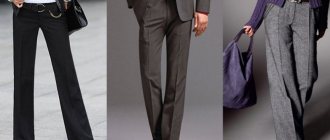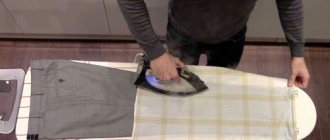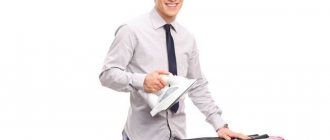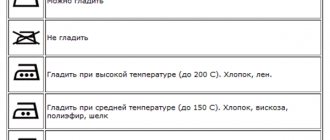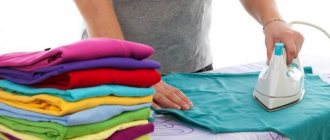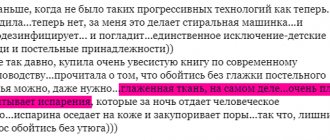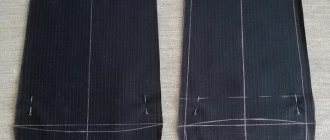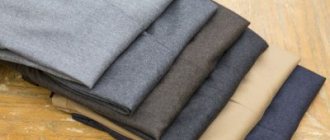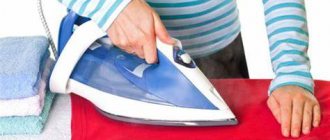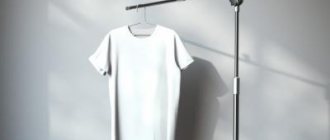Ironing clothes isn't always a pleasure, but there's no getting around it. It is especially difficult for young housewives to iron classic men's trousers that have creases. What girls don’t do is ironing the arrow so that it ends up in the right place and doesn’t run to the side. After reading these ironing rules, you will understand that you don't have to be a professional ironer to iron wrinkled pants. All you need to do is have the right accessories on hand and be a little smart.
Preparing for ironing
Before ironing your trousers, a little preparation is required. Make sure the item is clean. The presence of stains requires washing, since it is extremely difficult to remove them after contact with the iron. Getting rid of pellets will be important. Most often, dense fabric is rolled with the addition of woolen threads. A special machine or a sharp blade will help you remove them . The work of removing pellets is painstaking, but necessary. After they disappear, the product will take on a new, neat look.
It is important to understand that most fabrics used to sew dress pants must be washed by hand or in a machine with a “delicate wash” setting. During intensive washing or dynamic spinning, the item may shrink, and not a trace will remain of the arrows. Also, the process of subsequent ironing is facilitated by proper drying of the product. If you are used to drying your trousers by hanging them upright on a line, fold the trouser legs in the direction of the arrows. The same actions are appropriate when drying folded trousers on a fabric spread on a flat, hard surface.
Trouser pockets must be cleared of foreign objects , be it metal keys, small change or crumpled pieces of paper. If you don't take care of cleaning your pockets, you can not only ruin your trousers, but also scratch the soleplate of your iron. In addition, colored pieces of paper in pockets may fade and stain the pants when ironed. It is almost impossible to remove such stains in the future.
Make sure that not only the trousers are clean, but also the surface used during ironing, as well as the iron. A dirty and greasy sole will leave greasy stains and stains on the product.
What tools will you need?
In order to iron trousers with creases, you will need the following tools:
- ironing board or smooth, flat surface without chips or cracks;
- iron with steam generator (or steam generator separately);
- gauze or thin plain fabric;
- a spray bottle filled with clean water;
- vinegar essence;
- a small piece of soap;
- starch.
Vinegar, laundry soap (or soap) and starch may not be needed, but should be on hand for an emergency. They are used to iron creases on stale trousers. You may also need pins to help pin your pants in the right place so they don't move around on the board.
Which iron mode should I choose?
Before setting the iron's setting, pay attention to the label sewn onto your trousers. On it, manufacturers indicate various symbols as a hint to help iron it without damaging the product .
So, a crossed out iron indicates that the product cannot be ironed. The crossed out steam emanating from the iron in the picture is a sign that it is strictly forbidden to steam the trousers, otherwise the fabric may shrink significantly. A regular iron allows you to iron the product. The dots shown on the label indicate the temperature at which ironing is permitted. One point allows ironing at a temperature not exceeding 110 degrees, two points - at a temperature not exceeding 150 degrees, three - up to 200 degrees.
What to do if the tag on your trousers is missing? Pay attention to what fabric the trousers are made of, this will help you choose the desired mode. For example, synthetic fabrics can be ironed at a temperature no higher than 90–100 degrees, wool allows you to increase the temperature to 120–130 degrees, and natural fabrics such as cotton or linen – up to 180–190 degrees. Lining fabrics are smoothed at the minimum setting.
IMPORTANT! Start ironing with a small piece of fabric and gradually increase the temperature.
Step by step ironing guide
For perfect ironing of trousers you need:
Turn inside out
First of all, you need to iron the pockets, this will help avoid wrinkles. Here you may need a towel, which must be placed between the inside-out pockets and the main fabric. Now you can begin ironing the waistband and lining fabric. To iron the lining, keep the iron temperature to a minimum, otherwise the fabric may melt.
Turn the pants right side out
The top needs to be ironed. To avoid wrinkles on the back side, place a towel inside between the legs. To prevent excessive gloss from appearing on the trousers, place gauze on the fabric, pre-soaked in water or vinegar, which can be replaced with a plain, light-colored cotton fabric.
Fold and iron
We fold the trousers on a flat surface along the seams and iron the fabric without affecting the creases. If the seams turn out, straighten them out. Each trouser leg should be ironed one at a time, not overlapping each other. Here you will need gauze again. Moisten it often with clean water, or spray water onto the gauze from a spray bottle. After the main part of the product has been ironed, it’s time to start ironing the arrows.
IMPORTANT! The higher the temperature of the hot iron, the more often you wet the gauze with water.
Iron from the inside out
Why turn your pants inside out? Some fabrics do not accept ironing at high temperatures, and it is very difficult to iron the arrows with a warm iron, so for the best result, iron the product from the wrong side, and the arrows themselves from the front side. It is also convenient to iron pockets and lining fabric from the inside out. Even if the gloss does not appear on trousers ironed from the front right away, it may appear over time.
Process the front side
After the back side and pockets are ironed, we begin processing the front side.
Fold both trouser legs so that the seam is in front of your eyes. That is, all the arrows on the trousers must match. Pins, needles or office clips can help prevent the trouser legs from moving to the sides; they can be used to secure the trouser legs to the board, carefully pinning them together. Inspect the trousers; the crease at the bottom and the dart at the top should form a single, straight line. Cover the trousers with wet gauze and begin to iron the creases. If you are still not confident in your abilities and are afraid of moving the trouser legs, do not move the iron while ironing, but simply apply it to the arrows for 5–7 seconds. Sometimes the difficulty lies in the fact that some trouser models have not one, but two undercuts . A few tricks will help you deal with the arrows:
- start ironing from the right groove;
- Next we iron the one that is closer to the codpiece;
- Only after this do we iron the creases on the trouser legs.
Useful tips
Now you already know how to iron perfectly straight lines on your pants, so here are some useful tips for proper ironing or in emergency situations.
- If the fabric on your knees has stretched and lost its shape, then go over the fabric with a damp cloth using tangential movements. Return them to their original shape, and only then iron them.
- If the material is natural, then sew the arrows with thread before washing. This way they won't fall apart. Iron as usual.
- You can try to remove the crease in the trouser leg left after lengthening with damp gauze. Iron from the inside out to prevent the fabric from becoming shiny. Set the maximum permissible temperature for a certain type of fabric. Place the iron on the gauze and wait until it dries completely. If necessary, repeat the procedure until the crease disappears completely.
The fact that I meet people by their clothes has long been known from folk wisdom. If you steam and iron your pants correctly, you will look brand new. Ideal arrows add a plus to your karma in the eyes of others, while double or unclear ones will spoil the opinion of you. The acquired knowledge and constant practice will help you keep your wardrobe in order.
What are soap, vinegar, starch used for?
At the beginning of the article, we mentioned that you may need soap, starch and apple cider vinegar, previously diluted in water, as tools. What are all these funds needed for?
Use a piece of laundry soap to run along the entire length of the arrows from the wrong side.
Then turn the trousers inside out and iron the creases. Soap will give the fabric the missing rigidity and the arrows will turn out sharper. The most difficult part to iron is the creases on the top of the trouser legs. A starch paste will come to the rescue, which can be used to moisten the underside of the arrows. Start ironing after the starch has dried .
Vinegar will help prevent shine from the iron on the fabric. Dilute vinegar in clean, cool water in the proportion of 1 tablespoon per 1 liter of water. Soak gauze or cotton cloth in this essence and carefully place it on the fabric while ironing. It is not recommended to put on trousers immediately after ironing with vinegar; let them cool for a few minutes.
How to consolidate the result?
We told you all the intricacies of preparing trousers for ironing and the process of ironing creases. Let's talk about how to consolidate the result.
You ironed the product perfectly, put it on and were satisfied, but even the perfect result is temporary. After the first wash, the creases on the trousers will disappear, and all work will have to start all over again. To make the task of ironing the arrows as easy as possible, add a pinch of dry starch to the water during washing, after which the fabric will become stiffer . After washing, avoid vigorous spinning and allow the remaining water to drain off on its own.
Proper drying of the product will also help to consolidate the result. You can dry your trousers in a vertical or horizontal position. The first method involves the presence of a trouser hanger through which they are thrown. The arrows must connect to each other. Horizontal drying requires spreading the wet product on a dry, dense cloth that absorbs water well. To do this, you can use a large terry towel spread on a flat, hard surface. The arrows should similarly be carefully straightened and connected to each other.
To iron or not?
How to iron trousers with creases, if such an item is a must-have attribute of your wardrobe. The arrows on the pants appeared not by chance, and arose in connection with the development of conveyor sewing production.
Thanks to the compact packaging of the trousers and long-term transportation around the world, the presented wardrobe item came out with a caked bend.
At that time, they didn’t even try to smooth it out, since it signaled the novelty of the thing and was considered a sign of wealth.
Despite the fact that such pants are no longer considered fashionable, they indicate the neatness and composure of the owner and are part of a business wardrobe.
Now clothes go on sale with already marked marks on the legs. However, periodically it is washed, after which the arrows disappear.
To restore its former beauty and restore symmetry, let's learn how to iron perfectly.
The process of ironing fashionable linen requires the development of specific skills and knowledge of some nuances, which we will tell our readers about later.
What to do if it turns out uneven?
Only an experienced housewife who has been ironing for several years can iron trousers perfectly the first time. Few young girls are proud of their first result in ironing arrows. What to do if the arrows turn out to be uneven?
Do not iron both trouser legs at the same time; do this work first on one, then on the other . You won't be able to get the job done quickly, and the result may be disappointing. Holding the iron in your hand, use a steam generator, this will speed up the process and improve the result. If your iron is not equipped with automatic steam, and you often have to iron trousers, be sure to purchase a steam generator. Wet the gauze frequently in water or vinegar solution. When ironing the arrows, apply maximum effort while pressing on the iron.
Tricks of the professionals
Professionals will tell you what tricks to use during ironing in order to achieve maximum effect and not ruin your trousers:
- To avoid shine, soak the gauze not in water, but in vinegar diluted with water;
- use a vertical steamer, this will help avoid kinks in the fabric;
- A comb with wide teeth, through which you can pull the wet trouser leg along the entire length, will help you to draw the arrow evenly;
- coat the inner line of the arrows with a piece of laundry soap;
- the arrows will be straighter if you start ironing from the middle of the trouser leg, that is, from the knee, gradually moving first in one direction, then in the opposite direction;
- after ironing, let the arrows dry;
- do not put on your trousers immediately after ironing, let them hang for 20-30 minutes, this will fix the result of the work.
How to wash a terry robe
How to hem men's trousers correctly
When is gauze needed?
A piece of white gauze still remains an attribute for steaming clothes.
Gauze is needed if the surface of the product has at least a little hairiness . A thin cloth will prevent the pile from sticking and help maintain the appearance of the product.
Gauze is necessary for ironing light-colored trousers; it will help avoid stains that the iron can leave. It is used for clothing made of wool and polyester to avoid the appearance of weasels.
Instead of gauze, it is better to use a piece of madapolam . This material is called gauze. Its thickness is the same as gauze, and the weave is a little tighter.
Gauze holds moisture better. The density of the weaving more reliably protects the surface of the product from damage.
